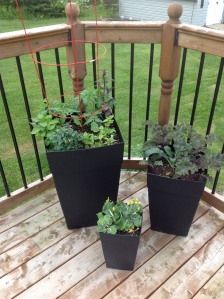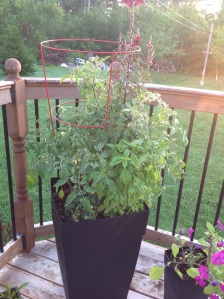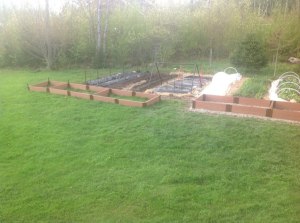Beginning any new task is very daunting for me. I like to know what I am getting myself into and I like to know all the steps before I begin. I don’t mind adjusting on the fly, but flying blind is not for me. After writing about a few of our successes, trials and plans in seeding, gardening and lighting I received a request for a specific post – How do I get started on a small veggie garden without getting overwhelmed? I am certainly no expert in this area – but this is how I started laying down roots, how I dreamed and triumphed and of course how I could have done it better. I hope it helps a bit.
MY TOP 10 STEPS FOR STARTING A NEW VEGGIE BED
10 – SUCCESS! Site Selection – The soil in my yard is quite heavy with a lot of clay. I also have a lot of trees that cast weird shade. We started by finding a flat site and staked out a 10×20 foot square. We watched where the shadows were throughout the day and adjusted the location of our square to make sure we had as much sun as possible throughout the day. We also made sure the hose and sprinkler would reach. I use a lot of planters on the deck and patio and fill them with veggies – even my 2×2 planters produce a pile of tomatoes and chard and are very pretty when planted with a few annuals or herbs for a splash of colour. Added bonus – planters can be hauled inside during summer hurricanes!

9 – FAIL – Could have done better….Soil Preparation – The first year, we dug out the sod (we needed it in other places anyways…), pulled as many big rocks out as we could and turned the “soil” (it was really clay) with shovels. We added bags of peat moss and compost and had 2 yards of garden soil dumped in the back of our truck and dug that all in too. I did buy a soil test kit and a pH tester, but I am not sure they were ever very accurate and never repeated the process out of laziness and distractedness.

The start of year 3.
What we have since done better – in subsequent years of expansion we borrowed and then purchased a root-tiller to till the original plot – soooo much easier than hand-bombing it with shovels. We also lost the rock and clay battle and chose instead to have more garden soil or triple mix delivered to “build up” our soil. Instead of cutting out the sod, I laid cardboard down in the area to become the garden. We then dumped 10-12 inches of soil on top of the cardboard. By the end of the summer, the cardboard had broken down the sod and the garden soil was much more productive than our natural soil even with the amendments.
Better still – 2 years ago we bought composite raised bed kits. We placed a few inches of crusher dust and gravel underneath the boards to level them, lined them cardboard and then filled with garden soil and triple mix. Each bed is 4×8 feet and 12 inches deep. They were much more expensive, but by far the best approach for us. After we clean up the gardens in the fall, I cover the beds with straw to keep weeds down and turn it under in the early spring with a fresh top up of organic fertilizer and compost – less weeds, more yield and no boulders to be dug! SCORE!
8 – SUCCESS! Hilling my rows – We get a lot of rain and I found that in the main garden, I lose less soil and seedlings to run off and drowning if I create hilled rows. I mark where my rows should be (they are pretty set now after 6 years and it reduces work and soil compaction by keeping my rows in the same places.) I make my rows approx 2-3 feet wide by 10-12 inches high with a hoe so I can plant a few rows of treats in each hill or plant in clumps. The water runs off into the lower paths between rows and it seems to keep the roots watered while keeping puddles in the actual rows to a minimum. This doesn’t apply to my raised beds as the drainage is really good and we don’t walk in them anyways.
7 – SUCCESS!! 2 foot paths between rows – just enough space to kneel in and get the wheelbarrow through! Enough said…
6 –SUCCESS!!! Weed barriers – I HATE WEEDING!!! We almost plowed down the dirt and seeded the plot with grass a few summers ago because the weeding was becoming all consuming! They were shading out veggie babies, providing hiding spaces for slugs and bugs and smothering everything edible (as well as smothering my desire to garden anymore….) With two busy girls, a full time job and the desire to do something other than pull weeds every non-scheduled waking moment, I caved and bought weed barrier. AND THE ANGELS SANG – AHHHHHHHHHHH!!!!! (That was supposed to be angels singing in harmony with the sun shining brightly and me frolicking in a long shimmery dress with flowers in my hair! Yup, the result was that good!!)
The cost is not prohibitive – less than $60 per season. I place cardboard or wet newspaper between the rows, then place black bio-film over my prepped rows as tight as I can, staking it with ground stakes or rocks. I then cover the newspaper or cardboard with clean straw (not hay!!!) In order to seed, I use an exact-o knife to cut slits or small holes and plant seedlings or seeds through the holes. The black film does triple duty – it heats the soil, prevents run off and SMOTHERS THE WEEDY INVADERS!!!! It is the rock star of my garden. I haven’t had to use it in my raised beds yet because the soil was relatively weed free, but I will as soon as I get overrun again. The prep work is a lot more but last summer I spent less than 10 hours total weeding the veggie beds. FREEDOM!!!



5 –Success, partially – Electric fencing. This was a must for us. The deer were eating the veggies faster than we could grow them. A simple electric fence made for small animals was cost-effective, not too unsightly and keeps the deer out magnificently! It does not keep out racoons or rabbits….that is a battle for next summer….If your garden is small, a fence would be ideal. Mine is 40×24 and it would far too expensive to do a pretty fence.
4 – SUCCESS (after a few years) – Bird netting, frost blankets and hoop tunnels – These little beauties did not come until 2 years ago, but I wish I had started from the get-go with them. They can be easily thrown up quickly and protect veggies and berries from animals, frost, hail, winds and sun. I found frost blankets at the Dollarama last year – JACKPOT!
Hoop tunnels are just 6 foot long sections of 3/4 inch PVC pipes. I slide them over 1 foot rebar stakes that I pound into the ground on each side of the row. They act as mini greenhouses and allow me to plant much earlier and later than the frost dates. I use 4 hoops for a 14 foot row. As a cover, I bought 6 mm vapour barrier plastic, laid out 18 feet of it (it was 8 feet wide) and stapled 14 foot decking boards down the two long sides. I rolled the boards in the extra plastic (since the hoops were 6 feet wide – the extra is nice as it keeps the staples from being pulled out). Hubby helped me carry the boards and plastic to the garden and laid a board in each path on either side of the row, with the plastic resting on the PVC pipes. I can easily lift one board up and over the hoops to uncover or recover as necessary for picking or airing out. I found green plant clips at the dollar store that clamp the plastic to the hoops nicely. Niki Jabbour’s book, The Year Round Vegetable Gardener has some easy instructions for making these.
3 – FAIL – High quality sprinkler – cheap ones just don’t cut it. I have spent more in cheap sprinklers than I would have had I sucked it up in the first place. In ground drip irrigation would be lovely….someday maybe!
2 – SUCCESS! Strong vertical supports – for peas, poles beans, tomatoes, cucumbers and squash. I use everything from cages to bamboo to saplings. Vertical supports make the garden interesting, pretty, save space and keep produce off the ground. Plus there is nothing neater for a little kid than a pole bean teepee or a squash house to hide in!
AND MY NUMBER 1 STEP FOR STARTING A GARDEN….drumroll please…..
1 – Minions for planting!!!! The more hands, the better! Little hands are capable of so much and bring so much joy, excitement and fulfilment to the garden, as long as I am willing to have a few crooked rows and a few surprises!
I have made lists of veggies that have worked well for our family in Nova Scotia. I use calendars to remember when to plant what – you can find them in O-Seed-D if you’d like to take a peek. I found the best way to decide what to grow is to figure out what we will actually eat and ask other gardeners around me what varieties have worked best in our area. Nova Scotia is full of great resources, I only listed a few in Borrowed Wisdom, but I go back to them all the time – I learn something new every time I read the same old books!
“If you have a garden and a library, you have everything you need.” ~Marcus Tullius Cicero







What a great list, I’ve gone through many of the same steps you have but your garden looks much better managed than mine. We started our garden approximately the same time (5-6 years ago) but there’s still lots I would change. I need to remove all the grass around my veggie garden, so tired of it invading my beds. and better use of space. I made my paths too wide and now I wish I could turn them into more garden space.
LikeLiked by 1 person
I think that is my favourite part of gardening – it can always be changed up! Are your beds all raised? I have seen creeping thyme between rows that looks like a lot of fun and smells so good when you step on it. I suspect it may be invasive as well, but prettier and more useful than grass! I hate pulling grass from my flower beds, makes me a bit crazy – I am trying to find a better barrier for these beds now, but I don’t want to restrict reseeding and spreading of my perennials with weed barrier….any ideas?
LikeLike
What a wonderful, informative post here today, thank you for all the wise wisdom. Love the look of your raised beds.. Happy gardening to ya, from Laura ~
LikeLike
Thanks Laura, always enjoy your company!
LikeLiked by 1 person
Thanks for sharing. I am tempted to fashion a green house over at least one of my garden beds. I’ll have to check out the book you mentionned
LikeLiked by 1 person
It is a great book, especially for us since she is local! She has a new book out full of garden plans and a great blog too – http://yearroundveggiegardener.blogspot.ca
I would love to have a greenhouse someday, but for now, the little hoop tunnels are my powerhouses in the garden – a close second to weed barrier!!
LikeLike
Thanks for the link! I don’t think we have enough room for a green house but the hoop tunnels would be a great addition 🙂 Do you have tips about growing tomatoes on your deck?
LikeLike
I am starting my tomato seeds this week – maybe a good topic for a post?! When I do tomatoes on the deck, I make sure I use at least 12 inches of soil poured over pop bottles or plastic containers for drainage. I prefer lightweight plastic in the bottom of my planters so that I can actually move the planters around to chase the sun or bring them in if it is in climate weather. I bury the seedlings as deep as I can – right up to the top set of leaves – so that they can develop very strong root structures. I only put 1 or 2 tomatoes per square foot and then some pretty annuals and basil around them to attract pollinators. I use an extra sturdy cage (and pretty ones) and place it as soon as I plant the seedlings. I normally use pre-mixed Pro mix, which is peat and perlite so that it is light and holds moisture. I also spray out the planters with a light bleach solution each year to kill any disease hiding in the soil from last year (blight is my worst tomato enemy). Last year’s soil gets used in other planters for just flowers or dumped into the main garden where no tomatoes or potatoes will be planted that year. I fertilize with compost tea or organic fertilizer every few weeks. Seems to work for us – we get our best yields from the deck planters! Hope that helps!
LikeLiked by 1 person
Thank you for that! It would be a great idea for a post indeed 🙂 I started a couple of seedlings 2 weeks ago (black cherry) but I’m tempted to start some more classic varieties for this summer
LikeLiked by 1 person
Sold! I will take pictures of my wee one planting and write a little something up then!
LikeLike
great, thanks again 🙂
LikeLike
Smashing post! I like that you pinned your failures with your successes; these are as important in the overall success of any garden. It’s always try and try again in mine. Persistence and flexibility is everything.
Have you heard of a lasagna garden? Sod or no, you basically build a (layered) compost pile right where you want to plant, and then PLANT. No purchasing of dirt, putting lumber frames together, just lots of happy microbes and underworld creatures to do your ’tilling’ for you. It’s not failed me yet!!
Thankful we have no multitudes of deer to contend with here in Suburbia, so no fencing (yet). I share a portion of my yield with squirrels, birds, and caterpillars, but we still have plenty to bring in to eat. I guess that means everyone’s happy.
Cheers! And Happy Gardening!
PS – I sent you a webmail…you won! (http://wp.me/28k6D) Still want that DVD? Reply when you can.
LikeLike
Yay! I love winning prizes, that makes me very happy! I have not tried lasagna gardening, it sounds fantastic! I will have to do some more research on this for sure! My sister is hoping to start a garden, maybe I can use her yard as an experiment! The only problem I can foresee is that the racoons love our compost pile, so I tend to keep it back in the woods so as not to attract them too close to the house or gardens. Hmmmm…..a secret garden in the woods perhaps to feed the beasties?!
LikeLike
I have a book you can have…I’ll send it with your DVD. How’s that sound?
LikeLike
Sounds amazing! I am not sure how to check webmail? Is that just through the hotmail address associated with this blog? Newbie 🙂
LikeLike
Webmail is email via the internet (rather than downloaded). I used the address associated with your comment. Would you like me to resend?
LikeLike
That would be great! novascotiaroots@hotmail.com 🙂
LikeLike
Done! Check your inbox.
LikeLike
I will do a post on it soon as I’m building a new bed lasagna style as I type. It’s super easy to do! No tilling, grass removal, or wooden boxes or soil required. I will plant directly in it for spring fruits. Stay tuned!
LikeLike
Looking forward to it!
LikeLiked by 1 person
There is nothing in my lasagna piles (or compost) for the coons to eat, so though we do have them, they are not a problem. I think the ‘supplies’ you build your pile with is key (leaves, twigs, hedge trimmings, grass clippings) and to bury your kitchen waste deep into it and cover with more compost (or better, manure).
LikeLike
That is where I am definitely lazy – I just chuck my kitchen veggie waste right on the top of the pile!! I suppose burying it would make more sense!
LikeLike
Yep. That’ll do it! It’s an all-you-can-eat raccoon buffet! Belly up. 😀
LikeLiked by 1 person
There was nothing in my hotmail and the link brings me to your blog, but I am not sure what I am looking for 😦
My hotmail account is novascotiaroots@hotmail.com if you are willing to resend old-school!
LikeLike
What a great post! Moving has given me a few gardens over the past six years or so and I’ve had my share of lessons learned (and relearned!) It’s funny how climate differences can change successes and failures. I tried black plastic mulching here because it worked well where I grew up. Here it cooks the soil and kills everything because it gets too hot! Your garden looks so lovely. Thanks for sharing its history.
LikeLike
This is our 4 home in 13 years, my gardens have taken on all sorts of shapes and sizes for sure – this one is the first that I have been able to develop fairly well! Our last home was in Northern Alberta, I couldn’t even grow a tomato on the deck….it is funny how different climates can be – have you tried red plastic mulch instead? Maybe it wouldn’t cook so badly?
LikeLike
I haven’t and I might. So far I’ve had the best luck with a deep layer of leaves.
LikeLike
Do they block the weeds well? Maybe that would be a good thing for me to try in my raised beds as I tend to plant much more intensively in them than the rows.
LikeLike
They do for me, but they also allow for rollie pollies and snails, so it isn’t a perfect system.
LikeLiked by 1 person
Wow ! Thanks for the visit to my blog and SO glad to see yours! You are way ahead of me in this journey & I am learning lots already from you. Following!
LikeLike